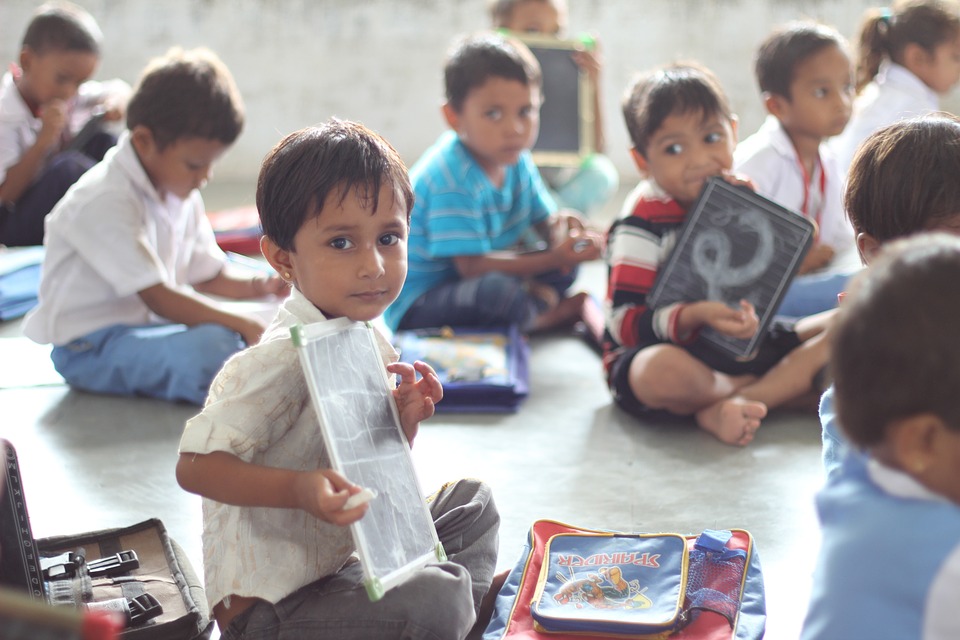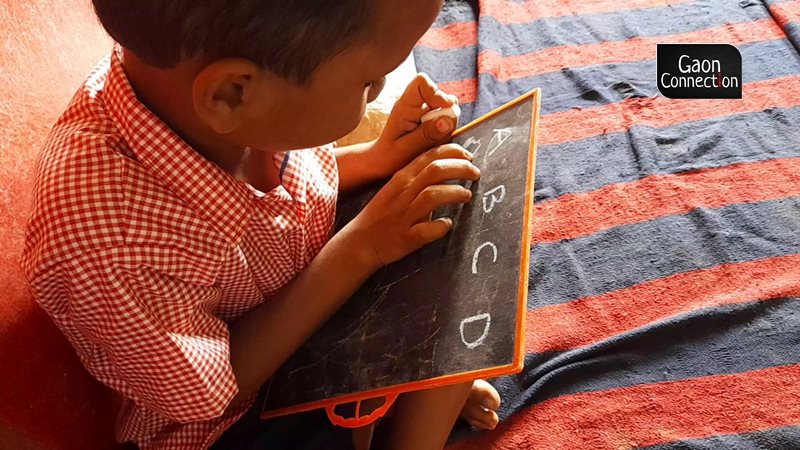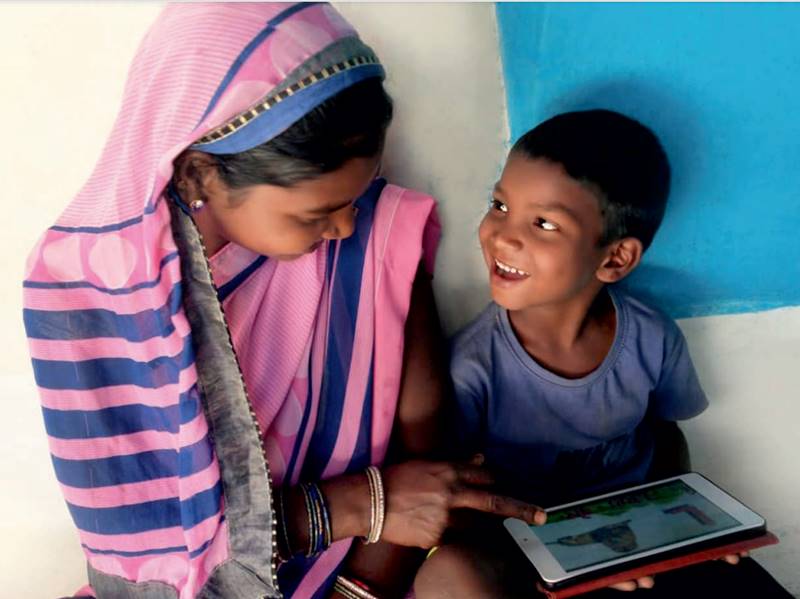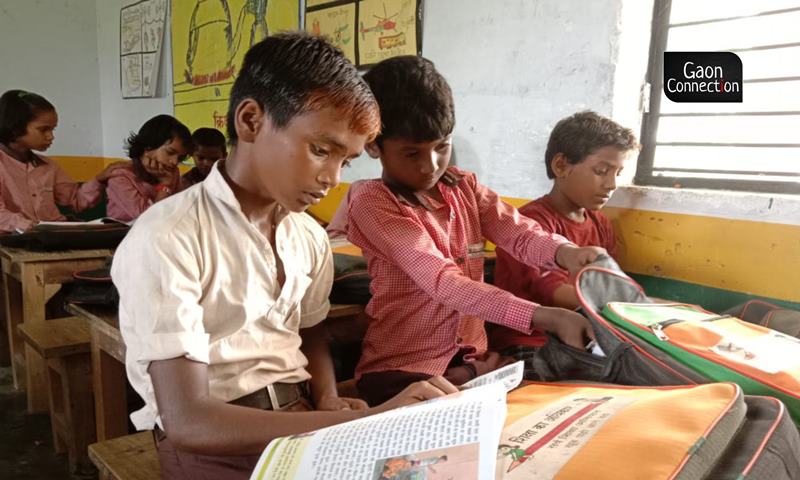With an increased allocation to education, Budget 2022 focuses on e-learning, but will it bridge the digital divide?
Finance Minister Nirmala Sitharaman announced that the government will launch a digital university and increase the ‘One Class One TV Channel’ from 12 to 200 TV channels, among other things to bring rural children at par with their urban counterparts. Gaon Connection spoke to education sector experts to elicit their comments and this is what they had to say


The finance minister made a slew of announcements in the 2022 budget session that included setting up of a digital university with class quality universal education and personalised learning experience for students across the country. Photo: By arrangement
There has been an increase in the education budget for the year 2022-23 to Rs 104, 278 crores (budget estimates) as compared to last year when the budget estimate was Rs 93, 274 crores (revised to Rs 88,002 crore). The union budget has laid a lot of emphasis on digital learning since students’ have suffered due to numerous school closures ever since the onset of the pandemic.
The finance minister made a slew of announcements in the 2022 budget session that included setting up of a digital university with class quality universal education and personalised learning experience for students across the country. She announced that the university will be built on a network hub and spoke model with the collaboration of the best public universities.
“Due to the pandemic induced closure of schools, our children particularly those from rural areas and those from scheduled caste and scheduled tribes, and other weaker sections have lost almost two years of formal education. Mostly, these are children in government school. We recognise the need to impart supplementary teaching and build a resilient mechanism of education delivery,” the minister said while presenting the budget today morning in parliament.
Sitharaman also underlined that in order to make up for the lost two years of formal education due to continuous disruptions, the government will expand PM e-VIDYA initiative wherein the ‘One class One channel’ will be expanded from 12 to 200 television channels. This is an attempt to enable all states to provide supplementary education in regional languages to children in classes 1 to 12, the finance minister added.

In the Budget 2022-23, the National Education Mission has received Rs 39,553 crore, which is more than the revised estimate (Rs 30,796 crore) for the mission last year.
In the light of the above announcements, Gaon Connection spoke to a number of experts in the education sector, including school principals and teachers, to understand the impact of these allocations.
“The government’s intentions are good but students don’t have access to smartphones to watch videos,” said the principal of a primary school in Barabanki, Uttar Pradesh. “There are 300 students enrolled in my school. When I went to pay them a visit, I found out that only 20 students had access to televisions. In such a scenario, how will the One class One TV channel initiative benefit the kids in rural India?,” he asked.
These digital learning schemes are a step in a good direction but only benefit those who already have access to resources, the principal told Gaon Connection on the condition of anonymity.

Difficult to bridge the digital divide
“These just seem to be general and notional schemes. The students for whom they are building these digital universities barely have access to them so for whom are they building these universities?” Paul Divekar, the chairperson of Asia Dalit Rights Forum, told Gaon Connection.
A survey-based study by the National Campaign on Dalit Human Rights (NCDHR)’s Dalit Adhikari Andolan found one out of every second Dalit and tribal student, interviewed as part of a survey, couldn’t avail online classes due to the unavailability of android phones/laptops.
The NCDHR’s report titled Confronting the Pandemic: Response and Recovering for Dalit and Adivasi students released in October 2021 had highlighted that twenty-two percent of students from these marginalized communities didn’t have access to internet facilities in their villages that affected their education in the COVID19 pandemic.
Highlighting the digital divide in urban and rural India, Divekar said, “If one goes to any part of Delhi, they have access to the internet but the facility of optical fibre lines is not available at the village level. They have been announcing to bridge the digital divide for a decade but nothing has been done.”

Also Read: Every second surveyed Dalit and Adivasi student couldn’t access online classes: NCDHR report
According to a report titled COVID-19 and School Closures: One year of education disruption released by the United Nations Children Emergency Fund (UNICEF) in 2021, merely 8.5 per cent students in India have access to the internet.
The pandemic, lockdowns and the subsequent closure of schools had impacted 201 million students worldwide. Out of these, 170 million students had no access to education for the past one year, the UNICEF report stated.
Adding more to the discourse, the Barabanki principal stated that the school teachers try to raise awareness about the government run TV shows, radio programmes and share links of e-pathshala with the parents but many families still can’t afford a smartphone which affects the students’ education.
Sandeep Rajput, who runs mobile schools for migrant children and children who have been left out of schools in Gurgaon’s Bhondsi district, told Gaon Connection that the government should come up with initiatives for children which will ensure their overall development and make provision for physical activities too.
“Children have been staying at home for the last two years which have severely impacted them. They need to be brought out of homes. Ensuring digital education is a good step for those who can afford it but a solution needs to be devised for those who have been left out of this system like children of migrant workers,” Rajput said.
He also added that many families still depend on keypad mobile phones instead of smartphones and the high data plans can’t be afforded by everyone.

E-learning is the way forward
But, education sector experts also support e-learning. “E-learning is the way through which we can connect to students. We might not have the same facilities as the first world but we have to start somewhere,” Santosh Kumar Biswal, an assistant professor at Symbiosis Institute Of Media And Communication, Pune told Gaon Connection.
The assistant professor said that the announcements in the budget 2022 were a step in the right direction. “The concept of e-learning is not new but has been accelerated because of the pandemic,” he said.
Biswal also added that the central government needs to work in tandem with the state government to ensure proper implementation and suggested that the government should also tie-up with organisations such as UNICEF for more support.

“These are progressive initiatives, timely and need to be welcomed. The ‘One Class One TV channel’ initiative is also a good step to reach the masses. It will also give a boost to access to quality education in many regional languages so that’s an important aspect in the education sector,” Hepesh Shepherd, Principal of Salvation Tree School in Noida, Uttar Pradesh, told Gaon Connection.
While he welcomed the increase in budget and stated that it’s in line with Kothari’s commission’s recommendation of allocating 6 per cent of total GDP (gross domestic budget) for education, Shepherd also outlined that fund cutting in scholarship for girl children, especially those belonging to scheduled caste and scheduled tribe section is a cause of concern.
With inputs from Virendra Singh, Barabanki, Uttar Pradesh.

